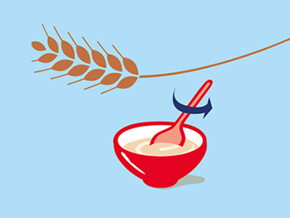
QUINOA: Can It Address My Growing Child’s Nutritional Needs?
Once your baby reaches six months of age, you will need to start introducing additional food to their diet to make sure that they are getting all the nutrients they need. Read article to know more.
Once your baby reaches six months of age, you will need to start introducing additional food to their diet to make sure that they are getting all the nutrients they need1,2 and ensure they enjoy a healthy transition from infancy to toddlerhood.3
One way of introducing nutrient-dense solid food to your baby is through fortified cereals. Studies have shown that infants who were given cereals fortified with multiple micronutrients were less likely to develop anaemia4-7 Now you can further improve the quality of fortified cereals—by adding quinoa, the ‘superfood’ 8,9 to the cereal mix.
What is quinoa?
Quinoa has been used in some parts of the world for thousands of years10, however, worldwide production and consumption increased exponentially after 2013, which was designated the international year of quinoa by the Food and Agricultural Organisation of the United Nations (FAO).8,11;
The quinoa plant produces a small flat seed that can range in colour from pink to black, but is usually pale yellow.12 The fact that it has a high protein content and is micronutrient-rich, gives it a nutritional advantage over other grain products.10
What are the nutritional benefits of quinoa?
Quinoa is rich in proteins, fibre, fatty acids, vitamins, and minerals. It offers a balanced blend of essential amino acids.10
Proteins:
The protein content of quinoa is higher than other cereals.8 However, what makes quinoa really unique is the balance of amino acids, the building block of protein. The amino acid profile of quinoa exceeds the recommended values given by the FAO for all nine essential amino acids that cannot be produced by human body.8,11 In fact, the high protein quality of quinoa makes it a more complete protein than most vegetables.12
Fibre:
Quinoa is an excellent source of fiber10, which may be beneficial for the digestive health of babies.13 This helps to establish a positive association between food and eating right from the very beginning.
Vitamins and minerals:
These are micronutrients, present in smaller quantities, but still essential for growth and development. The mineral content of quinoa is typically higher than other grain cereals; including higher levels of magnesium, potassium, zinc and iron.10,12 Infants between the ages of 6 and 11 months are particularly susceptible to iron deficiencies16 and this can be alleviated, at least in part, by adding iron fortified infant cereals to a child’s diet.
Quinoa is a good source of the B vitamins, riboflavin (B-2) and folic acid (B-9).8 It also contains vitamin E, which is a powerful antioxidant that helps protect your baby’s healthy cells11,17
Enjoy the nutritional benefits of quinoa, when your growing child’s nutritional needs are at their peak.18
References:
1.Complementary feeding. WHO.
2.Fewtrell M, et al. J Pediatr Gastroenterol Nutr. 2017;64(1):119-132.
3.Infant and Young Child Nutrition.; 2002.
4.Eichler K, et al. BMC Public Health. 2012;12(1):506.
5.Gibson RS, et al. J Nutr. 2011;141(5):935-943.
6.Awasthi S, et al. Br J Nutr. 2020;123(7):780-791.
7.Fotedar A, et al. J Fam Med Prim Care. 2018;7(1):77.
8.Angeli V, et al. Foods. 2020;9(2).
9.Van den Driessche JJ, et al. Food Funct. 2018;9(4):1944-1966.
10.Filho AMM, et al. Crit Rev Food Sci Nutr. 2017;57(8):1618-1630.
11.Nutritional value- International Year of Quinoa 2013.
12.Abugoch James LE. Adv Food Nutr Res. 2009;58:1-31.
13.El Khoury D, et al. J Nutr Metab. 2012;2012:851362.
14.Rodríguez-Cruz M, et al. Rev Invest Clin. 57(3):457-472.
15.Borsonelo EC, et al. Prostaglandins Leukot Essent Fat Acids. 2008;78(4-5):237-245.
16.Butte NF, et al. J Am Diet Assoc. 2010;110(12):S27-S37.
17.Ng SC, et al. Food Chem. 2007;101(1):185-192.
18.Black RE, et al. Lancet. 2008;371(9608):243-260.




















